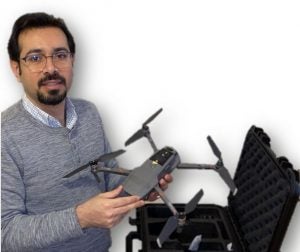Improved safety for UAVs in construction target of grant
Not surprisingly, construction work is among the most hazardous jobs in the United States. A grant awarded to East Carolina University looks to help change that.

Dr. Mostafa Namian, assistant professor in the Department of Construction Management, has received a $75,000 grant from the U.S. Department of Labor’s Susan Harwood Training Program to develop new training and educational materials on the hazards of the use of unmanned aerial vehicles in the construction industry. (Contributed photo)
Dr. Mostafa Namian, assistant professor in the Department of Construction Management, has received a $75,000 grant from the U.S. Department of Labor’s Susan Harwood Training Program to develop new training and educational materials on the hazards of unmanned aerial vehicles in the construction industry. The use of UAVs can help detect hazards at construction sites, thus improving worker safety.
“One in five workers’ deaths in the U.S. was in construction. That is 20% of the overall occupational fatalities, while the industry accounts for only 5% of the workforce,” Namian said. “In addition to the ordinary hazards normally present in dynamic construction workplaces, UAVs can expose workers to a range of never-before-seen safety risks that must be recognized and controlled. However, the industry is not equipped with safety measures to prevent potential accidents due to scarce research on drone-associated hazards and risks.”
Along with co-principal investigator Dr. George Wang, chair of the Department of Construction Management, Namian and graduate student Mohammad Khalid will work to develop training materials that will include safe use as well as hazard recognition of UAV use in construction. The materials will be in English and Spanish.
A 1 1/2-hour training session for up to 20 workers will also be developed. Namian is planning those sessions for July through September.
Namian, an authorized construction safety trainer for the Occupational Safety and Health Administration,said UAV use in the construction industry is growing. He noted a 2018 survey in which year-to-year growth was estimated at 239%, “mainly because of its easy accessibility, superior productivity and economic feasibility,” he said.
He said UAVs can be used for construction surveys, topographic mapping, site inspections, safety planning, equipment tracking, project progress monitoring, laser scanning and photogrammetry, and thermal image recording — all of which can be used to increase worker safety at job sites.
Anyone interested in the training can contact Namian via email at namianm19@ecu.edu or Khalid at khalidm20@students.ecu.edu.
— Ken Buday